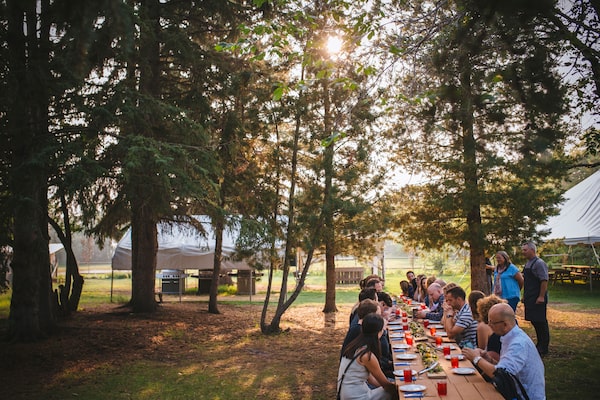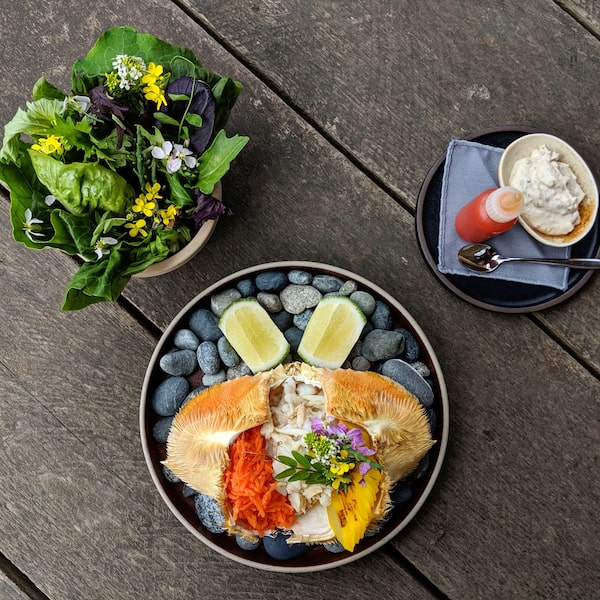
A RGE RD Farm Dinner at Prairie Gardens in Bon Accord, Alta.Detour Photography/Handout
In 2003, food writer, researcher and activist Anita Stewart put a call out to her network of chefs, farmers and home cooks to address a mounting crisis. Sanctions on Canadian beef exports due to a single case of BSE – bovine spongiform encephalopathy, commonly known as mad cow disease – were destroying Canadian farm communities.
Stewart decided to initiate what she called the world’s largest barbecue, inviting chefs and home cooks across the country to grill Canadian beef in their own backyards on the Saturday of the August long weekend and share their menus and stories. In response, she received hundreds of calls and e-mails detailing the private and public gatherings around Canadian tables.
“It’s all about pride of place, making us more aware of what we have here – I don’t think we can take it for granted,” says Stewart, who has authored a dozen books on the subject of Canadian food and our culinary history.
The event was more than a success. “It was a bit of a rallying cry for all Canadians to dig in and support their neighbours,” says Joyce Parslow, executive director of consumer relations at Canada Beef. "We were amazed by the response of the Canadian public ... that they stood strong with ranchers and beef farmers. ... It was one of the only times on record that a crisis like that has seen domestic consumption increase. We kind of credit that with saving the beef industry.”
Since then the grassroots movement has been driven by celebrity chefs and social media, elevating our restaurant scene and educating Canada about what grows and lives here – and who’s growing, raising and preparing it. And in 2010, Stewart dubbed the first Saturday of the August long weekend Food Day Canada. But, at a time when growing your own tomatoes and spending a Saturday at the farmers market have become de rigueur, it might be hard for industry outsiders to understand why campaigns like this are still needed.
But Stewart says there’s still more to be done. “We need to encourage Canadians to be more proud of who we are as a food nation – as a people who understand and cook from our own foodshed. And to keep our farmers in business – that’s so important," she says.
After all, the agri-food industry is responsible for one in eight Canadian jobs and generates $100-billion – more than the GDP of two-thirds of the countries in the world.

Anita Stewart and Chef Warren Barr enjoy a cookout at The Wickaninnish Inn in Tofino, B.C., in 2016.Handout
“People don’t understand that their actions can have a big impact on their rural neighbours,” Parslow says. “If we want to continue to have Canadian foods and have these things grown close to home, we have to think about our food actions – it does make a difference to buy a strawberry here."
Since its inception, countless chefs, who have established a stronger position of influence in recent years thanks to Food Network Canada and other media outlets and publications, have participated in Food Day Canada by planning special meals and events, using their platforms to amplify the stories behind all that is grown and raised here. “Food Day Canada has really validated and supported the pursuit of Canada’s culinary identity and acts as such a great platform to bring like-minded chefs together,” says Warren Barr, who has been involved since the beginning. “Without it, we might still be wallowing in maple syrup and poutine.”
Now the chef-owner of the newly opened Pluvio Restaurant + Rooms in Ucluelet, B.C., Barr is running a special three-course menu on Aug. 3, featuring some of the restaurant’s favourite producers and winemakers. “Our food and beverage program is already hyper-locally focused, so we’ll be drawing attention to some specific ingredients that aren’t just local, but sustainable and/or tell a great story,” he says. One example is “Mushroom Mike," he adds, a guest who started growing oyster and shiitake mushrooms and picking chanterelles for the restaurant.

Pluvio is running a special three-course menu on Aug. 3, featuring some of the restaurant’s favourite producers and winemakers.Pluvio restaurant + rooms/Handout
The menu will focus on a zero-waste philosophy, with ceviche using off-cuts from a ling cod and halibut dish, and fish bones used in a chilled fish broth to be served with sustainable side stripe shrimp harvested on Vancouver Island. All of the produce is sourced from the Tofino Ucluelet Culinary Guild, a collaborative organization of Vancouver Island farmers, fishermen, foragers and food producers that sells directly to chefs and local consumers through a good food box program and community markets.
As a writer, researcher and advocate for Canadian food since the eighties, Stewart recalls a time when local was far from a priority in restaurant kitchens. “It’s been a 180-degree shift,” she says, adding that Quebec and the Pacific Northwest have always had more of a local focus, but she still had to look for chefs who sought out and promoted local ingredients. Now, she says, sourcing local food is “just what we do.”
Stewart, who was appointed to the Order of Canada in 2012 for her contributions, sees Canadian chefs not only as extraordinary talents worth celebrating, but as brand advocates for local food who have a unique ability to catalyze policy action, foster leadership and educate consumers. “From Old Crow to Signal Hill to Tofino, it crosses all food systems, geographic, professional and party lines,” she says. “Food unites us – it’s political without being divisive.” But she also encourages home cooks to get involved by supporting growers in their areas and sharing not only their meals, but their market finds or preparation ideas – something that’s easier to do in the age of social media. “The real food of Canada is in the home kitchens,” says Stewart, adding that cooking knowledge is essential to a healthy culinary culture.
This year, Food Day Canada has gained enough traction to warrant even broader recognition: landmarks across Canada, from the Confederation Building in St. John’s to the Kwanlin Dun Cultural Centre in the Yukon, to the parliament buildings in downtown Victoria, will light up on and around the day in honour of our farmers, producers, cooks and eaters. On a long summer weekend when many of us are already spending time with friends and family, it’s a simple yet meaningful celebration of our collective food culture and an industry we’re all connected with every day. “It’s a day to light a campfire, dig a roasting pit, or sweep off the deck for a neighbourhood supper,” Stewart says, “and use Canadian ingredients to create a simple dinner or feast that honours our extraordinary history.”
With a diverse terroir on and between our coastlines, our range of culinary traditions is equally vast. “Canadian cuisine is a moving target – food is always on the move,” she says. “If you want to define it, it has to be ultimately regional, defined by the history of each region, the weather, geography, immigration patterns, who was here, the ability of the First Nations to communicate their stories – all these play into what Canadian cuisine is and will be. We’re not a melting pot, we’re a smorgasbord.”
Live your best. We have a daily Life & Arts newsletter, providing you with our latest stories on health, travel, food and culture. Sign up today.